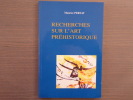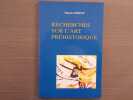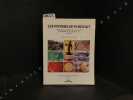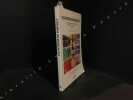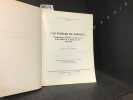-
Type
Book (30675)
Disk (1)
Engraving (1)
Magazine (1074)
Old papers (2)
Photographs (2)
Reprint (4)
-
Latest
Last 24h (7)
Last 3 days (3)
Last month (1919)
Last week (14)
-
Language
Chinese (1)
Dutch (20)
English (50)
French (31649)
German (16)
Italian (15)
Latin (4)
Portuguese (1)
Spanish (3)
-
Century
16th (3)
17th (14)
18th (60)
19th (1863)
20th (14664)
21st (1800)
-
Countries
Belgium (3990)
Brazil (1)
Canada (6)
China (15)
Côte d'Ivoire (79)
Denmark (486)
France (22960)
Greece (7)
Netherlands (1743)
Switzerland (2472)
-
Syndicate
ALAC (6)
CLAM (41)
ILAB (12044)
NVVA (1082)
SLACES (1082)
SLAM (10403)
SNCAO (71)
Gallo-Romains, Wisigoths et Francs en Aquitaine, Septimanie et Espagne.
Ministère de la Culture, Direction du Patrimoine, Sous-Direction de l’Archéologie, 1991, in-4to, XVI + 257 p., richement ill. n./b. et couleurs, brochure originale.

(SLACES, NVVA)
Phone number : 41 (0)26 3223808
Nouvelles annales publiées par la section française de l'Institut archéologique.
Paris, Bourgeois-Maze [puis :] Brockhaus-Avenarius, 1836-1839 4 vol. in-8, VI-297 pp., pp. chiffrées 299-560, [4]-190 pp., et pp. chiffrées 191-618, avec 19 planches hors-texte, brochés sous couvertures imprimées de l'éditeur. Abondantes rousseurs.
Apparemment tout ce qui a paru. Sous ce titre, un comité composé du duc de Luynes, de Quatremère de Quincty, de Félix Lajard, de Désiré Raoul-Rochette, de Jean de Witte, de Letronne et Charles Lenormant, reprenait en partie le contenu et les communications des Annali dell'Instituto di corrispondenza archeologica, publiées à Rome depuis 1829 jusqu'en 1853. - - VENTE PAR CORRESPONDANCE UNIQUEMENT
Préhistoire du feu.
Paris, Masson 1977, 240x160mm, 180pages, broché.
illustrations n/b in et hors texte, Pour un paiement via PayPal, veuillez nous en faire la demande et nous vous enverrons une facture PayPal
Recherches sur l'art préhistorique.
Louis Jean Gap 2001 In-8 ( 240 X 160 mm ) de 170 pages, broché sous couverture illustrée. Planches hors-texte. EDITION ORIGINALE. Très bel exemplaire.
Die keramik der älteren römischen kaiserzeit in mähren --- opera univesitatis purkynianae brunensis facultas philosophica 112
Universita J.E. Purkyne 1966 in8. 1966. Broché. illustrations en noir et blanc
Bon état couverture ternie bords frottés
PERNON, Jacques et Christine - Revue Archéologique de Narbonnaise
Reference : 104454
(1990)
Les potiers de Portout. Productions, activités et cadre de vie d'un atelier au Ve siècle ap. J.C. en Savoie - Revue Archéologique de Narbonnaise supplément N° 20
1990 Revue Archéologique de Narbonnaise - Supplément 20 - Editions du CNRS - 1990 - 1 vol in-4 - Broché, couverture illustrée - 215 pages + XLVII planches- Illustrations en noir & blanc en et hors texte
Bon état - Marques de frottements à la couverture - Coins un peu cornés Bon
Les gaulois.
Seuil. 1979. In-4. Relié. Bon état, Couv. convenable, Dos satisfaisant, Intérieur frais. 126 pages - jaquette en bon état - nombreuses illustrations en noir et blanc dans et hors texte.. Avec Jaquette. . . Classification Dewey : 930.1-Archéologie
Classification Dewey : 930.1-Archéologie
Les Gaulois
Seuil 1979 Grand In-8 broché 28 cm sur 20. 126 pages. Assez bon état d’occasion. Poids sans emballage : 571 grammes. Edition entièrement revue, augmentée et mise à jour de l’édition de 1957. Brillante synthèse, richement illustrée, qui a connu un franc succès en son temps.
Edition entièrement revue, augmentée et mise à jour de l’édition de 1957. Brillante synthèse, richement illustrée, qui a connu un franc succès en son temps. Bon état d’occasion
L'oppidum de Joeuvre (Loire) de l'Age de Fer au Bas-Empire - étude archéologique - préface de Robert Périchon
Opus 1987 in8. 1987. Broché. iconographie en noir et blanc
couverture défraîchie ternie intérieur propre bonne tenue
L'oppidum de Joeuvre (Loire), de l'Age du Fer au Bas-Empire. Etude archéologique.
Badaroux, Organisation pour la Publication de Travaux d'Intérét scientifique (O.P.U.S) Cévennes, Causses, Gévaudan, 1987. Broché, couverture illustrée. in-8 de 157 pages, 50 planches (photos, illustrations, plans, cartes).
Phone number : 06 80 15 77 01
Coup d'oeil sur le Bourbonnais préhistorique.
Dijon, Revue Préhistorique illustrée de l'Est de la France, [1905] ; in-8, broché. 11pp.-2 planches hors-texte. Bon état.
Tiré à part de la Revue préhistorique illustrée de l'Est de la France. Pérot fait un inventaire rapide des découvertes archéologiques dans le département, depuis l'époque Tertiaire jusqu'à l'Age du Fer
Les eaux du Mont-Dore dans l'Antiquité. Les sculptures et la statue bouddhique du Panthéon.
Clermont, Mont-Louis, 1904 ; plaquette in-8, brochée. 31pp. Figures in-texte. Bon état.
Tiré à part de la Revue médicale du Mont-Dore.
Les âges préhistoriques.
Moulins, Crépin-Leblond, 1891 ; in-12, broché. 119pp. - 2 grandes planches dépliantes hors-texte (lithographiées en bistre). Petit manque angulaire de papier à la couverture supérieure.
L'auteur tente d'établir une chronologie des différentes étapes de l'évolution humaine aux temps préhistoriques à partir des découvertes archéologiques faites aux XIXe siècle dans le monde. Il ne manque jamais de rattacher les découvertes faites en Bourbonnais à chacune de ces périodes lorsque celà lui paraît possible. Les planches présentent six type de silex taillés et 12 exemples de pierres polies issues des collection de F. Pérot.
L'âge du Bronze en Bourbonnais.
P., Vigot Frères, 1906 ; plaquette in-8, brochée. 7pp. Bon état.
Article tiré à part de la Revue préhistorique N°, 1906. Pérot fait l'inventaire des déciouvertes archéologiques de cette période dans le département de l'Allier.
Recherches sur la présence de coquilles d'huitres et d'autres mollusques marins dans les ruines gallo-romaines du Centre de la Gaule.
Autum, Tiré à part des Procès-verbaux de la Socité d'histoire naturelle d'Autum, 1906 ; plaquette in-8, brochée. 20pp. Rousseurs sur la couverture.
Avec un envoi autographe de l'auteur à M. Ernest olivier, direteur de la Revue Scientiique du Bourbonnais.
M. VALENTIN-SMITH, conseiller honoraire à la Cour d'Appel de Paris, officier de la Légion d'Honneur et de l'Instruction Publique, membre honoraire du Comité des Travaux Historiques et de la Société Archéologique et Historique de l'Orléanais.
Orléans, Herluison, 1891, 1 broché. in-8 de 7 pages.
Joannès-Erhard Valentin-Smith, né à Trévoux (Ain), d'une famille parlementaire des Dombes.Extrait du "Bulletin de la Société archéologique et historique de l'Orléanais".
Phone number : 06 80 15 77 01
Le guide du patrimoine : Ile-de-France.
Paris, Hachette, 1992. 13 x 25, 750 pp., 16 cartes en couleurs, reliure d'édition carton imprimé, bon état.
Le vieux Chambéry. Guide historique et archéologique. 2e Edition.
Chambéry, Librairie Dardel, 1937, pt. in-8vo, 194 p., + 2 plans dépliants (la ville de Chambéry en 1729 / Chambéry et ses faubourgs au XVIIIe siècle), demi-cuir aux coins, dos à 4 nerfs, titre orné or au dos.
L’édition originale a été publiée en 1921 par Dardel. Guide historique et archéologique du vieux Chambéry. Perret 3373.

(SLACES, NVVA)
Phone number : 41 (0)26 3223808
LES CITES DU DELUGE / COLLECTION LES PREMIERS MATINS DU MONDE
FRANCE-EMPIRE. 1979. In-8. Broché. Etat d'usage, Couv. convenable, Dos satisfaisant, Intérieur frais. 230 pages - nombreuses photos et illustrations en noir et blanc dans et hors texte.. . . . Classification Dewey : 930.1-Archéologie
Classification Dewey : 930.1-Archéologie
LES CITES DU DELUGE. LES PREMIERS MATINS DU MONDE
France Empire Paris, France Empire 1979. In-8 broché de 230 pages, photos. Bel exemplaire
Toutes les expéditions sont faites en suivi au-dessus de 25 euros. Expédition quotidienne pour les envois simples, suivis, recommandés ou Colissimo.
Les cités du déluge
,Paris, France-empire Les premiers matins du monde 1979, 230 pp., 1 vol. in 8 br. illustrations in et hors-texte
Les cités du déluge. En 2 volumes.
Couverture rigide. Reliure de l'éditeur. 2 volumes de 250 pages.
Livre. Editions Famot, 1982.
Les pierres qui parlent
Editions France-Empire. 1977. In-8. Broché. Bon état, Couv. convenable, Dos satisfaisant, Intérieur frais. 312 pages augmentèes de nombreuses photos, illustrations et dessins en noir et blanc dans le texte.. . . . Classification Dewey : 930.1-Archéologie
Les premiers matins du Monde. Collection dirigèe par Christian Bernadac. Classification Dewey : 930.1-Archéologie
Les pierres qui parlent.
P., France Empire, 1977, in 8° broché, 318 pages, illustrations.
PHOTOS sur DEMANDE. ...................... Photos sur demande ..........................


Phone number : 04 77 32 63 69
 Write to the booksellers
Write to the booksellers
